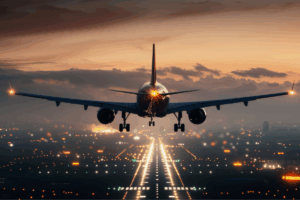Airport lighting stands out as a vital component of aviation safety, illuminating runways, taxiways, and other crucial areas, especially during the takeoff and approach of aircraft. Adequate lighting helps pilots discern the runway threshold, taxiway boundaries, and other critical markers, minimizing the risk of runway incursions and other potential hazards.
Technological advancements, including the adoption of LED technology and smart lighting systems, have enhanced the overall effectiveness of airport lighting, thereby contributing to improved safety.
Here are some of the most essential airport lighting innovations that keeps our airports operating with peace of mind and in compliance with governing safety standards.
Runway Lighting In Aviation Safety
In safe airfield operations, runway lighting stands head and shoulders above all else. Runway lights are strategically positioned along the edges and centerlines of runways to provide pilots with visual guidance during takeoff and landing. These lights help pilots establish and maintain the correct approach and alignment, ensuring a safe landing in varying weather conditions, including low visibility scenarios such as fog or heavy rain.
The Precision Approach Path Indicator (PAPI) is a precision lighting system that aids pilots in maintaining the correct glide path during approach. This system uses a combination of red and white lights to indicate whether an aircraft is too high, too low, or on the correct glide slope helping to improve airport safety.
Taxiway Lighting
Airport lighting extends beyond the runway to include taxiway lighting. Taxiways are the pathways that connect runways to terminals, hangars, and other essential airport facilities. Proper lighting on taxiways ensures pilots can navigate safely on the ground, avoiding collisions and maintaining a clear path to their destination.
Taxiway edge lights help define the boundaries of the taxiway, preventing aircraft from inadvertently veering off the designated path. Meanwhile, taxiway centerline lights guide pilots along the center of the taxiway, ensuring accurate navigation, especially in low-visibility conditions.
Approach And Apron Lighting For Aviation Safety
Approach lighting systems, often located at the end of runways, help pilots transition smoothly from the final approach to landing. These systems use a combination of sequenced lights to provide visual cues that assist pilots in aligning their aircraft with the runway.
The apron, where aircraft park, load, and unload passengers and cargo, also relies on carefully designed lighting for aviation safety. Apron lighting ensures safe ground operations during the critical phases of boarding and disembarking. Adequate lighting on the apron enhances the visibility of ground crew, equipment, and other aircraft, reducing the risk of accidents and ensuring a well-organized flow of operations.
Obstruction Lighting
Obstruction lighting is another crucial aspect of aviation safety. Tall structures such as communication towers, buildings, or wind turbines near airports must be equipped with proper lighting to make them visible to pilots, especially during nighttime or low-visibility conditions. These lights help pilots identify potential obstacles and navigate safely around them.
Read More: Obstruction Lighting
Wind Direction Indicators
Understanding wind conditions is essential for safe takeoffs and landings. Wind direction indicators, commonly in the form of wind cones, are illuminated to provide real-time information about wind direction and intensity. These tools aid in making informed decisions, such as selecting the appropriate runway for takeoff or landing based on prevailing wind conditions.
LED Technology
The integration of LED (light-emitting diode) technology has enhanced airport lighting efficiency, durability, and visibility, ensuring ongoing runway safety around the clock. LED lights offer better luminosity, consume less energy, and have a longer lifespan compared to traditional incandescent or fluorescent lights. This transition to LED lighting has not only improved the overall effectiveness of airport lighting but also contributed to environmental sustainability by reducing energy consumption.
Read More: The Evolution Of Airport Lighting Technology In Airport Runway Lighting
Automation And Smart Lighting Systems
Advanced automated and smart technology have their place in airport lighting systems. Automated systems can adjust lighting intensity based on environmental conditions, such as changing weather or time of day, optimizing visibility for pilots. These systems also enable remote monitoring and control, allowing airport authorities to respond promptly to maintenance issues and ensure continuous, reliable operation of the lighting infrastructure.
Airport lighting is an integral component of aviation safety, providing visual cues and guidance to pilots during critical phases of flight. As the aviation landscape continues to evolve, the crucial role of airport lighting remains steadfast in upholding the highest safety and operational efficiency standards.
Call Airport Lighting Company For The Latest In Airport Lighting Technology
The Airport Lighting Company team is standing by to answer your questions about how our tech-based products can help improve the safety, reliability, and efficiency of your runways. Call 315-682-6460 for fast, friendly service you can count on.


